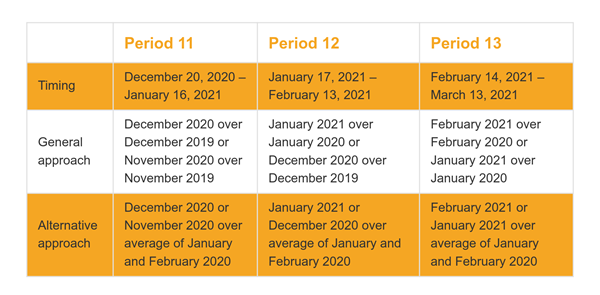Sales Tax Measures
GST/HST Relief on Face Masks and Face Shields
The Government proposes to temporarily relieve (i.e., zero rate) supplies of certain face masks (medical and non-medical) and face shields designed for human use that meet certain specifications

from the Goods and Services Tax/Harmonized Sales Tax (GST/HST). This measure would apply to supplies of these items made after December 6, 2020, and is proposed to only be in effect until their use is no longer broadly recommended by public health officials for the COVID-19 pandemic.
GST/HST on Cross-Border Digital Products and Cross-Border Services
The Government proposes a number of changes to the GST/HST system to ensure that the GST/HST applies in a fair and effective manner to the growing digital economy.
The Government proposes that non-resident vendors supplying digital products or services (including traditional services) to consumers in Canada be required to register for the GST/HST and to collect and remit the tax to the CRA on their taxable supplies to Canadian consumers.
In many instances, digital products or services may also be supplied to consumers in Canada through digital platforms that facilitate sales of third-party vendors (hereinafter referred to as a “distribution platform”). To ensure that the GST/HST applies equally to these supplies, it is also proposed that distribution platform operators be generally required to register for the GST/HST and to collect and remit the tax on the supplies that these platforms facilitate of digital products or services of non-resident vendors to Canadians.
The proposed new simplified system is intended to apply to non-resident vendors and non-resident distribution platform operators that are not carrying on business in Canada and have not registered under the normal GST/HST rules and would include the following key features:
- Simplified online registration and remittances: An online portal would be available for simplified GST/HST registration and remittances by non-resident vendors of digital products or services and non-resident distribution platform operators that facilitate the supply of a non-resident vendor’s digital products or services to consumers in Canada.
- Business-to-consumer supplies only: Non-resident vendors and non-resident distribution platform operators using the simplified registration system would be required to collect and remit the GST/HST only on the supply of digital products and services made to Canadian consumers (as distinct from supplies made to businesses).
- General Rule – Tax based on consumer’s residence: With certain exceptions, non-resident vendors and non-resident distribution platform operators would be required to collect the GST/HST on their supplies of digital products or services if the consumer’s usual place of residence is in Canada at the rate applicable in the province of residence. Exceptions would apply where a consumer’s usual place of residence is not an appropriate basis for determining where, or whether, the place of consumption is in Canada and if the GST/HST would apply.
- No input tax credits: Non-resident vendors and non-resident distribution platform operators using the simplified registration system would not be able to claim input tax credits to recover any GST/HST paid on their business inputs. Those non-resident vendors and non-resident distribution platform operators that wish to claim input tax credits for the GST/HST paid may register under the normal GST/HST registration process.
- Registration threshold: Non-resident vendors and non-resident distribution platform operators making supplies of digital products or services to Canadians would be required to register for GST/HST purposes under the following circumstances:
- For a non-resident vendor, if their total taxable supplies of digital products or services made to consumers in Canada exceed, or are expected to exceed, $30,000 over a 12-month period (excluding supplies that are facilitated by a distribution platform operator that is registered for the GST/HST and that is deemed to have made the supply).
- For a non-resident distribution platform operator, if their total taxable supplies of digital products or services made to consumers in Canada, including the supplies of digital products or services of non-resident vendors to consumers in Canada that the operator facilitates, exceed, or are expected to exceed, $30,000 over a 12-month period).
The proposed new rules would apply to supplies of cross-border digital products or services to the extent that the consideration for the supply becomes due on or after July 1, 2021, or is paid on or after that day without having become due.
GST/HST on Goods Supplied through Fulfillment Warehouses

Non-resident vendors are increasingly selling goods to Canadians through digital platforms and online marketplaces, that facilitate sales of third-party vendors (hereinafter referred to as a “distribution platform”). These distribution platforms may also store the goods of third-party vendors in fulfillment warehouses in Canada and ship these goods to purchasers in Canada on a timely basis after the goods have been sold through the platforms.
There is generally no requirement under the current rules for the non-resident vendor, or distribution platform operator facilitating the sale, to collect or remit the GST/HST when the goods are sold to a purchaser in Canada. In order to level the playing field between resident and non-resident vendors, the Government proposes, among other things, to:
- Require distribution platform operators to register under the normal GST/HST rules and to collect and remit the GST/HST in respect of sales of goods that are located in fulfillment warehouses in Canada (or shipped from a place in Canada to a purchaser in Canada), when those sales are made by non-registered vendors through distribution platforms; and
- Require non-resident vendors to register under the normal GST/HST rules and to collect and remit the GST/HST in respect of sales of goods that are located in fulfillment warehouses in Canada (or shipped from a place in Canada to a purchaser in Canada), when those sales are made by the non-resident vendors on their own (i.e., they are not made through a distribution platform).
Distribution platform operators (whether resident or not) would be required to register under the normal GST/HST rules and to collect and remit the GST/HST if their total qualifying supplies (i.e., sales of goods that are located in fulfillment warehouses in Canada or shipped from a place in Canada to a purchaser in Canada), including those made through their platforms by non-registered third-party vendors, to purchasers in Canada that are not registered for the GST/HST (e.g., consumers) exceed or are expected to exceed $30,000 over a 12-month period.
Non-resident vendors that make sales of goods without the use of a distribution platform (e.g., by offering and selling the goods through their own website directly to Canadians) would also be required to register under the normal GST/HST rules if their total qualifying supplies to purchasers in Canada that are not registered for the GST/HST (e.g., consumers) exceed or are expected to exceed $30,000 over a 12-month period.
The proposed new rules would generally apply to supplies made on or after July 1, 2021 and supplies made before July 1, 2021 if all of the consideration is payable on or after July 1, 2021.
GST/HST on Platform-based Short-Term Accommodation
The GST/HST applies to supplies of short-term accommodation. For GST/HST purposes, short-term accommodation generally includes a residential complex or a residential unit that is rented to a

person for a period of less than one month.
In order to ensure that the GST/HST applies consistently and effectively with respect to supplies of short-term accommodation in Canada facilitated by platforms, the Government proposes to apply the GST/HST on all supplies of short-term accommodation in Canada facilitated through a digital platform (hereinafter referred to as an “accommodation platform”).
Under the proposal, the GST/HST would be required to be collected and remitted on short-term accommodations supplied in Canada through an accommodation platform by either the property owner or the accommodation platform operator as follows:
- The property owner (or person responsible for providing the accommodation – responsible person), where the owner (or responsible person) is registered for the GST/HST.
- The accommodation platform operator, where the property owner (or responsible person) is not registered for the GST/HST. In these circumstances, the accommodation platform operator would be deemed to be the supplier of the short-term accommodation.
An accommodation platform operator that facilitates or expects to facilitate over a 12-month period more than $30,000 in taxable supplies of short-term accommodation in Canada where the underlying third-party suppliers of the accommodation are not registered for the GST/HST would be required to register for and collect and remit the GST/HST on such supplies.
The proposed new simplified system would include the following key features:
- Simplified online registration and remittances: An online portal would be available for simplified GST/HST registration and remittances by non-resident accommodation platform operators that facilitate taxable supplies of short-term accommodation in Canada where the underlying third-party property owners/suppliers of the accommodation are not registered for the GST/HST.
- Business-to-consumer supplies only: Non-resident accommodation platform operators using the simplified registration system would be required to collect and remit the GST/HST on supplies of taxable short-term accommodation in Canada made to consumers.
- No input tax credits: Non-resident accommodation platform operators using the simplified registration system would not be able to claim input tax credits to recover any GST/HST paid on their business inputs. Those non-resident platform operators that wish to claim input tax credits for the GST/HST paid may register under the normal GST/HST registration process.
The proposed new rules would apply to supplies of short-term accommodation in Canada to the extent that the consideration for the supply becomes due on or after July 1, 2021, or is paid on or after that day without having become due.








